Plate and Tube Heat Exchanger Market by Material Type (Stainless Steel, Titanium Alloy, Copper, Aluminum, Nickel Alloys), End-use Industry (Chemical, Petrochemical & Oil, Gas, HVAC & Refrigeration, Power Generation), & Region - Global Forecast to 2028
The plate and tube heat exchanger market is projected to reach USD 884 million by 2028, at a CAGR of 6.5% from USD 645 million in 2023. Plate and tube heat exchangers represent a cutting-edge solution revolutionizing heat transfer mechanisms across industries. These advanced systems integrate diverse heat exchange techniques or materials within a singular unit, optimizing efficiency and adaptability in various industrial applications. Their versatility allows tailored solutions to specific industry demands, offering superior performance in critical sectors such as power generation, chemical processing, HVAC, and more. With a focus on enhanced efficiency and reduced environmental impact, these innovative heat exchangers pave the way for heightened operational efficiency, cost-effectiveness, and sustainability within diverse industrial operations.
Attractive Opportunities in the Plate and Tube Heat Exchanger Market
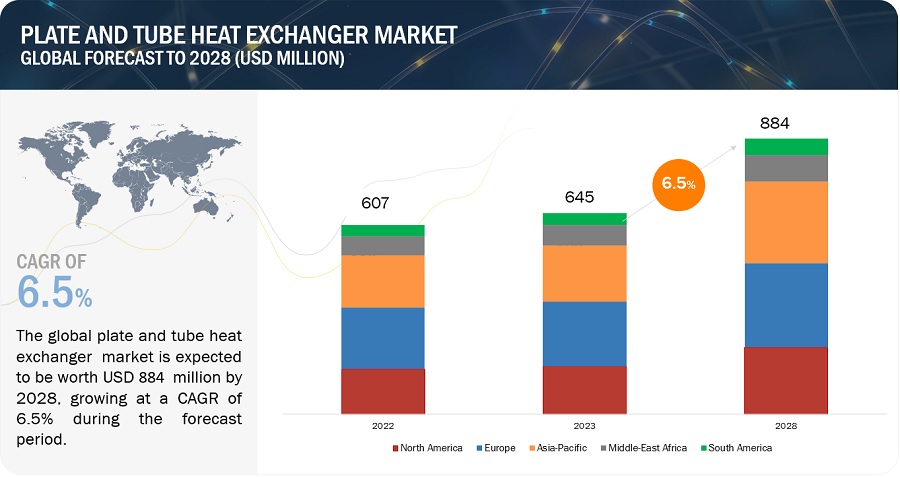
To know about the assumptions considered for the study, Request for Free Sample Report
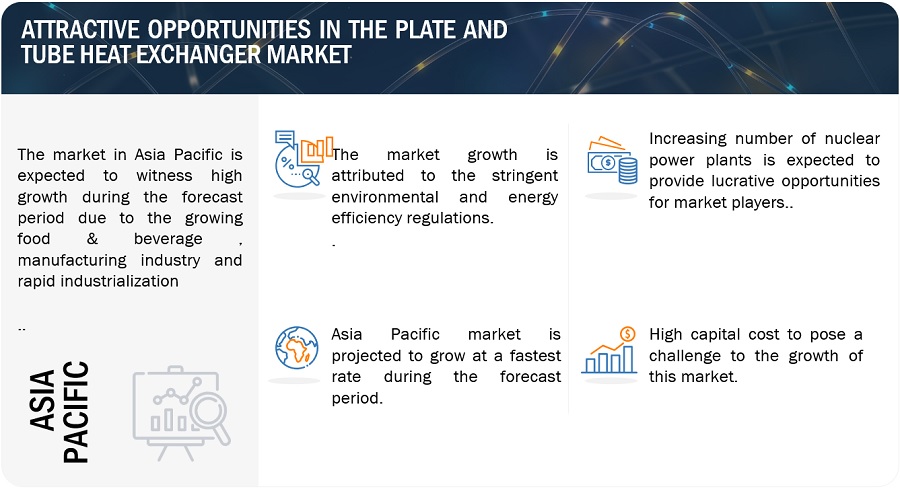
Plate and Tube Heat Exchanger Market Dynamics
Driver: Stringent environmental and energy efficiency regulations
The regulatory and sustainability mandates have increased the demand for energy efficiency. After the Kyoto Protocol that commits state parties to reduce greenhouse gases emissions, the pressure on the manufacturing industries to reduce both energy use and the associated CO2 emissions has increased. Plate and tube heat exchangers are far more environmentally friendly than other heating or cooling equipment and these do not use non-renewable fossil fuels such as coal or natural gas for heat transfer. Governments and regulatory bodies, especially in North America and Europe, are focused on deploying heat exchangers to reduce CO2 emissions and provide an energy-efficient solution. Moreover, sustainability along with energy efficiency is gaining more importance among end consumers. An efficient heat recovery process reduces energy consumption and helps in significant cost savings.
North America and Europe regions have stringent regulations towards energy efficiency. For instance, European Union’s directive 2010/75/EU regulation, which is based on the pollutant emissions from air, water & land, generation of waste, use of raw materials, and energy efficiency, states that industries worldwide should use the best technologies to prevent the CO2 emission so that it does not impact the human health as well as the environment. According to the US Department of Energy (DOE), 50% of the energy is utilized for operating residential and commercial infrastructure, and most of the energy is used by HVACR systems and appliances in the US. Energy Policy and Conservation Act of 1975 (EPCA), and DOE’s Appliance and Equipment Standards Program and Energy Efficiency Directive 2012/27/EU are some of the major energy efficiency and emission regulations and programs. These regulations are driving the demand for efficient HVACR equipment, including the plate and tube heat exchanger systems.
Restraint: Traditional design preferences
In various industries, the prevailing inclination towards conventional heat exchanger designs reflects a confidence born out of established practices and reliability. Companies have long relied on specific types of heat exchangers, like shell and tube or plate heat exchangers, due to their proven track record in delivering consistent performance. This deep-rooted familiarity often translates into a cautious approach when contemplating the adoption of innovative plate and tube heat exchanger technologies. Industries, especially those with critical processes, tend to be risk-averse, viewing any potential disruption caused by transitioning to hybrid designs as a perceived risk affecting operational efficiency. Furthermore, substantial investments in existing infrastructure, encompassing equipment, training, and maintenance protocols aligned with conventional heat exchangers, reinforce the preference for traditional designs. The potential need for significant alterations and added investments in infrastructure to accommodate plate and tube heat exchangers further solidifies this inclination. Moreover, apprehensions regarding the reliability and performance of newer hybrid designs, particularly in demanding operational settings, contribute to the reluctance in embracing these technologies. Overcoming these entrenched preferences necessitates a comprehensive showcase of the undeniable benefits offered by plate and tube heat exchangers, encompassing superior efficiency, cost-effectiveness, and adaptability. Concurrently, addressing concerns about reliability, performance, and compatibility with existing infrastructure is crucial.
Opportunity: Increasing number of nuclear power plants.
A plate and tube heat exchanger is an essential component of a nuclear reactor. According to the International Atomic Energy Agency (IAEA), the global tally of operational nuclear reactors stood at 443, with an additional 50 reactors under construction as of 2021, indicative of the ongoing expansion in nuclear power generation. Plate and tube heat exchangers assume a pivotal role in this landscape, serving as integral components in facilitating the transfer of heat from the primary reactor coolant loop to secondary systems, crucial for steam generation and subsequent electricity production. Their capability to enhance heat transfer efficiency, while being adaptable to varying temperatures and pressures, aligns perfectly with the demanding operational requirements of nuclear facilities. As the global nuclear power market size continues to project robust growth, estimated to surpass USD 205 billion by 2028, the industry's inclination toward innovative and advanced heat transfer technologies, including plate and tube heat exchangers, remains evident.
Moreover, with a heightened focus on environmental sustainability and the need to reduce carbon emissions, the efficiency and reliability offered by plate and tube heat exchangers contribute significantly to the overall performance optimization of nuclear plants.
Challenge: High capital cost
Entering and operating in the plate and tube heat exchanger market demands substantial capital investment due to the need for advanced manufacturing setups. Manufacturers must allocate significant funds towards research and development to create innovative, customer-centric products that align with specific application needs. These specific requirements across various industries add to the capital needs. Manufacturers are obliged to cater to diverse consumer demands while maintaining cost-effectiveness in production and operations. Additionally, addressing consumers' varied needs escalates the necessary capital for plate and tube heat exchanger production. Crucial factors like material grade, heat transfer efficiency, refrigerant capacity, as well as volume and durability, significantly impact manufacturing costs. Established companies channel a considerable portion of their earnings into R&D endeavors. Nevertheless, the presence of local manufacturers offering cheaper products intensifies market competition and poses credibility challenges for larger industry players.
Plate and Tube Heat Exchanger Market: Ecosystem
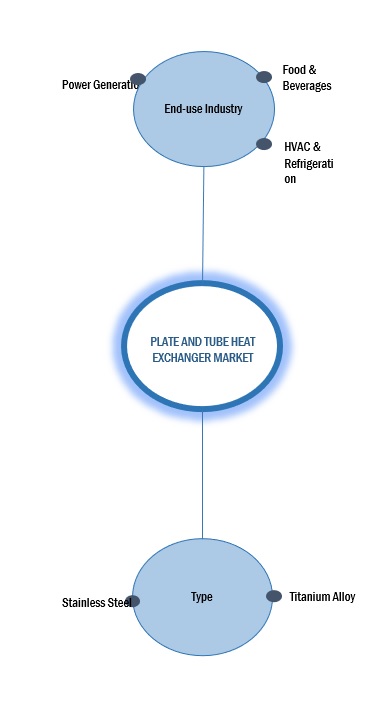
Source: Secondary Research, Interviews with Experts, and MarketsandMarkets Analysis
"Chemical Segment type was the largest segment for plate and tube heat exchanger market in 2022, in terms of value."
The chemical industry stands as a significant end-user sector for plate and tube heat exchangers, leveraging these systems for diverse applications. In chemical manufacturing processes, heat exchangers play a pivotal role in controlling temperatures during reactions, distillation, and condensation, ensuring efficiency and safety. The versatility of plate and tube heat exchangers allows them to handle varying chemical compositions and extreme operating conditions, making them instrumental in maintaining precise temperatures critical for specific chemical reactions. These heat exchangers aid in energy recovery, optimize process efficiency, and facilitate the cooling or heating of various chemical compounds or mixtures. With stringent quality standards and the need for reliable heat transfer systems in chemical processes, plate and tube heat exchangers offer a crucial solution, ensuring enhanced productivity and safety within the chemical industry.
"Asia Pacific was the fastest growing market for plate and tube heat exchanger in 2022, in terms of value."
Asia Pacific was the fastest growing market for global plate and tube heat exchanger market, in terms of value, in 2022. the region's robust industrial growth across sectors such as manufacturing, chemicals, power generation, and HVAC systems creates substantial demand for efficient heat exchange solutions. Moreover, the rising emphasis on energy efficiency and stringent environmental regulations in countries like China, India, Japan, and South Korea drives the adoption of advanced heat exchanger technologies. China is the largest market in Asia Pacific. India is projected to witness the highest growth during the forecast period .
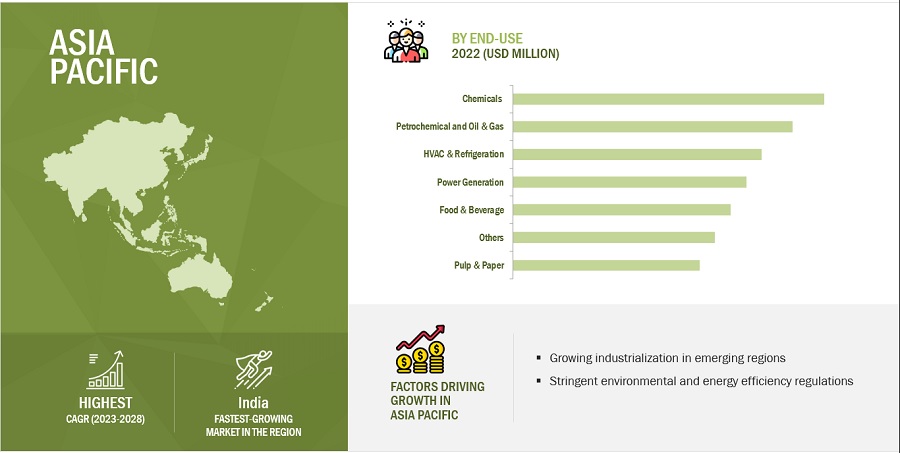
To know about the assumptions considered for the study, download the pdf brochure
Key Market Players
The key players in this market Alfa Laval (Sweden), Kelvion Holding GmbH (Germany), API Heat Transfer (US), HRS Heat Exchanger (UK), SPX Flow (US), Danfoss (Denmark), HFM Plate Heat Exchanger (China), Xylem (US), Wabtec Corporation (US), Thermex (UK). Continuous developments in the market—including new partnerships, mergers & acquisitions, agreements, and expansions—are expected to help the market grow. Leading manufacturers of plate and tube heat exchanger have opted for investment & expansion to sustain their market position.
Get online access to the report on the World's First Market Intelligence Cloud
- Easy to Download Historical Data & Forecast Numbers
- Company Analysis Dashboard for high growth potential opportunities
- Research Analyst Access for customization & queries
- Competitor Analysis with Interactive dashboard
- Latest News, Updates & Trend analysis
Request Sample Scope of the Report
Get online access to the report on the World's First Market Intelligence Cloud
- Easy to Download Historical Data & Forecast Numbers
- Company Analysis Dashboard for high growth potential opportunities
- Research Analyst Access for customization & queries
- Competitor Analysis with Interactive dashboard
- Latest News, Updates & Trend analysis
|
Report Metric |
Details |
|
Years considered for the study |
2019-2028 |
|
Base Year |
2022 |
|
Forecast period |
2023–2028 |
|
Units considered |
Volume (Units); Value (USD Billion) |
|
Segments |
Material Type, End-use industry, and Region |
|
Regions |
Asia Pacific, North America, Europe, Middle East & Africa, and South America |
|
Companies |
Alfa Laval (Sweden), Kelvion Holding GmbH (Germany), API Heat Transfer (US), HRS Heat Exchanger (UK), SPX Flow (US), Danfoss (Denmark), HFM Plate Heat Exchanger (China), Xylem (US), Wabtec Corporation (US), Thermex (UK) |
This report categorizes the global plate and tube heat exchanger market based on material type, End-use industry, and region.
Based on material type, the plate and tube heat exchanger market has been segmented as follows:
- Stainless steel
- Titanium alloy
- Copper
- Aluminum
- Nickel Alloys
- Others
Based on end-use industry, the plate and tube heat exchanger market has been segmented as follows:
- Chemicals
- Petrochemicals & Oil & Gas
- HAVC & refrigeration
- Food & beverage
- Power generation
- Pulp & paper
Based on region, the plate and tube heat exchanger market has been segmented as follows:
- Asia Pacific
- Europe
- North America
- Middle East & Africa
- South America
Recent Developments
- In September 2023, to meet the increased demand from various end-use industries, the kelvion expanded its production capacities in Sarstedt. The facility can now produce an additional 150,000 heat exchangers per year.
- In May 2022, Alfa Laval announced a joint venture with SSAB group (Global Swedish Steel Company) to produce the first heat exchanger made using fossil-free steel. The aim of this collaboration is to have the first unit made with hydrogen-reduced steel in 2023. This partnership will help Alfa Laval AB’s journey to becoming carbon neutral by 2030.
- In July 2021, Exchanger Industries, a Canadian market leader and manufacturer of heat exchanger products, acquired HRS Heat exchangers Limited. This acquisition helps EIL accelerate its expansion in power generation, storage, and biofuel applications.
Frequently Asked Questions (FAQ):
What is the expected growth rate of the plate and tube heat exchanger market?
The forecast period for the plate and tube heat exchanger market in this study is 2023-2028. The plate and tube heat exchanger market is expected to grow at a CAGR of 6.5 %in terms of value, during the forecast period.
Who are the major key players in the plate and tube heat exchanger market?
Alfa Laval (Sweden), Kelvion Holding GmbH (Germany), API Heat Transfer (US), HRS Heat Exchanger (UK), SPX Flow (US), Danfoss (Denmark), HFM Plate Heat Exchanger (China), Xylem (US), Wabtec Corporation (US), Thermex (UK) are the leading manufacturers of plate and tube heat exchanger.
What are some of the strategies adopted by the top market players to penetrate emerging regions?
The major players in the market use expansion, acquisitions, product launch, and partnership as important growth tactics.
What are the drivers and opportunities for the plate and tube heat exchanger market?
Growing industrialization in emerging regions is driving the market during the forecast period. Increasing number of nuclear power plants acts as an opportunity during the forecast period.
Which are the key technology trends prevailing in the plate and tube heat exchanger market?
The key technologies prevailing in the plate and tube heat exchanger market include smart heat exchanger, and nanotechnology. .
To speak to our analyst for a discussion on the above findings, click Speak to Analyst
The study involved four major activities in estimating the market size of the plate and tube heat exchanger market. Exhaustive secondary research was done to collect information on the market, the peer market, and the parent market. The next step was to validate these findings, assumptions, and sizing with industry experts across the value chain through primary research. Both top-down and bottom-up approaches were employed to estimate the complete market size. Thereafter, the market breakdown and data triangulation procedures were used to estimate the market size of the segments and subsegments.
Secondary Research
In the secondary research process, various secondary sources have been referred to for identifying and collecting information for this study. These secondary sources include annual reports, press releases, investor presentations of companies, white papers, certified publications, trade directories, certified publications, articles from recognized authors, gold standard and silver standard websites, and databases.
Secondary research has been used to obtain key information about the value chain of the industry, monetary chain of the market, the total pool of key players, market classification and segmentation according to industry trends to the bottom-most level, and regional markets. It was also used to obtain information about the key developments from a market-oriented perspective.
Primary Research
The plate and tube heat exchanger market comprises several stakeholders in the value chain, which include raw material suppliers, manufacturers, and end users. Various primary sources from the supply and demand sides of the plate and tube heat exchanger market have been interviewed to obtain qualitative and quantitative information. The primary interviewees from the demand side include key opinion leaders in end-use sectors. The primary sources from the supply side include manufacturers, associations, and institutions involved in the plate and tube heat exchanger industry.
Primary interviews were conducted to gather insights such as market statistics, data of revenue collected from the products and services, market breakdowns, market size estimations, market forecasting, and data triangulation. Primary research also helped in understanding the various trends related to technology, raw material, application type, end-use industries, and region. Stakeholders from the demand side, such as CIOs, CTOs, and CSOs were interviewed to understand the buyer’s perspective on the suppliers, products, component providers, and their current usage of plate and tube heat exchanger and outlook of their business which will affect the overall market.
The breakdown of profiles of the primary interviewees is illustrated in the figure below:
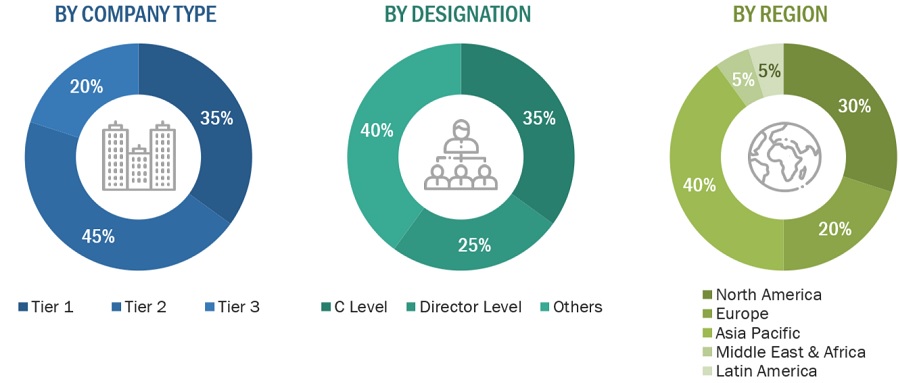
Note: Tier 1, Tier 2, and Tier 3 companies are classified based on their market revenue in 2022 available in the public domain, product portfolios, and geographical presence.
Other designations include consultants and sales, marketing, and procurement managers.
To know about the assumptions considered for the study, download the pdf brochure
|
Company Name |
Designation |
|
Alfa Laval |
Individual Industry Expert |
|
Kelvion Holding GmbH |
Sales Manager |
|
Xylem |
Director |
|
API Heat Transfer |
Marketing Manager |
|
HRS Heat Exchanger |
R&D Manager |
|
|
|
Market Size Estimation
The top-down and bottom-up approaches have been used to estimate and validate the size of the plate and tube heat exchanger market.
- The key players in the industry have been identified through extensive secondary research.
- The supply chain of the industry has been determined through primary and secondary research.
- All percentage shares, splits, and breakdowns have been determined using secondary sources and verified through primary sources.
- All possible parameters that affect the markets covered in this research study have been accounted for, viewed in extensive detail, verified through primary research, and analyzed to obtain the final quantitative and qualitative data.
- The research includes the study of reports, reviews, and newsletters of the key market players, along with extensive interviews for opinions with leaders such as directors and marketing executives.
Plate And Tube Heat Exchanger Market: Bottum-Up Approach

Note: All the shares are based on the global market size.
Source: Secondary Research, Interviews with Experts, and MarketsandMarkets Analysis
To know about the assumptions considered for the study, Request for Free Sample Report
Plate And Tube Heat Exchanger Market: Top-Down Approach

Data Triangulation
After arriving at the total market size from the estimation process explained above, the overall market has been split into several segments and sub-segments. To complete the overall market engineering process and arrive at the exact statistics for all the segments and sub-segments, the data triangulation and market breakdown procedures have been employed, wherever applicable. The data has been triangulated by studying various factors and trends from both the demand and supply sides. Along with this, the market size has been validated by using both the top-down and bottom-up approaches and primary interviews. Hence, for every data segment, there have been three sources—top-down approach, bottom-up approach, and expert interviews. The data was assumed correct when the values arrived from the three sources matched.
Market Definition
A plate and tube heat exchanger is a specialized heat transfer device that combines multiple heat exchange techniques or materials within a single unit to optimize efficiency, adaptability, and performance in various industrial applications. These heat exchangers typically integrate different heat transfer mechanisms, such as tube-and-fin configurations, enhanced surfaces, phase-change materials, or multiple materials like stainless steel and titanium alloys, to cater to specific industrial needs, maximize heat transfer rates, and minimize energy consumption.
Key Stakeholders
- Senior Management
- End User
- Finance/Procurement Department
- R&D Department
Report Objectives
- To define, describe, and forecast the size of the plate and tube heat exchanger market, in terms of value and volume.
- To provide detailed information regarding the major factors (drivers, opportunities, restraints, and challenges) influencing the growth of the market
- To estimate and forecast the market size based on material type, end-use industry and region.
- To forecast the size of the market with respect to major regions, namely, Europe, North America, Asia Pacific, Middle East & Africa, and South America, along with their key countries
- To strategically analyze micromarkets1 with respect to individual growth trends, prospects, and their contribution to the overall market
- To analyze opportunities in the market for stakeholders and provide a competitive landscape of market leaders.
- To track and analyze recent developments such as expansions, new product launches, partnerships & agreements, and acquisitions in the market.
- To strategically profile key market players and comprehensively analyze their core competencies.
Available Customizations
Along with the given market data, MarketsandMarkets offers customizations according to the company’s specific needs. The following customization options are available for the report:
Regional Analysis
- Further breakdown of a region with respect to a particular country or additional application
Company Information
- Detailed analysis and profiles of additional market players












Growth opportunities and latent adjacency in Plate and Tube Heat Exchanger Market